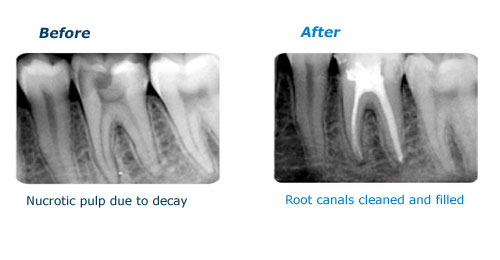
The signs/symptoms you should look out for could be –
(1) An infection or abscess (pimple) developed at the root tip, and or inside the tooth, or on the gums.
(2) Sensitivity to hot and cold, which could be caused by decay to the tooth pulp
(3) Severe toothache pain which could be caused by trauma and or injury to the tooth.
(4) Swelling and/or tenderness, possibly indicating infection.
Root canal procedures are necessary once the nerve of a tooth is actually afflicted with rot or even an infection. To avoid the loss of the actual tooth, the pulp (the living tissue inside the tooth), nerves, microorganisms, as well as any kind of corrosion are usually taken out as well as the resulting area will be filled up with specific medicated, dental components, which often re-establish the actual tooth to help return it to complete functionality.
A root canal performed on the tooth will be the treatment of choice in order to save the tooth which may have otherwise would have likely died and need to be taken out. Several individuals think that eliminating the tooth which has issues will be the answer, however what is not understood is that removing the tooth may eventually become more expensive as well as result in considerable complications with regard to nearby teeth.
Root canal procedures are actually very effective and also typically last a very long time, despite the fact that occasionally, the tooth must be retreated because of new bacterial infections.
What is involved with root canals?
Root canals usually take 1 or more appointments and they can be done by either a dentist and or endodontist (a root canal specialist).
The tooth will be numbed and a sheet of rubber (rubber dam) is place around the tooth to keep it saliva free and dry. The dentist will make an opening on the top of the tooth and with various dental instruments will remove the nerve tissue, pulp and any tooth decay/bacteria.
Once this is all done, the tooth is completely clear of all tissues etc, it will be sealed with either a temporary or permanent filling. If it is a temporary filling, the next appointment will normally be about a week later, the inside of the tooth will be filled and sealed with special materials. Then a filling and or sometimes a crown (cap) will be used to keep the tooth strong and prevent it from breaking, to last for many many years to come.
For the first little while after the procedure, your tooth can still be sensitive, however once the inflammation subsides and the tooth heals, the discomfort will diminish.
Remember good oral hygiene and regular dental visits will keep your teeth strong and beautiful and extending the life of your root canal.




